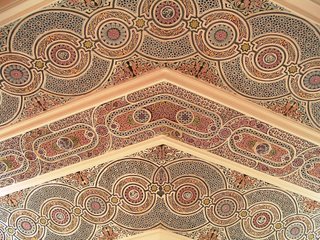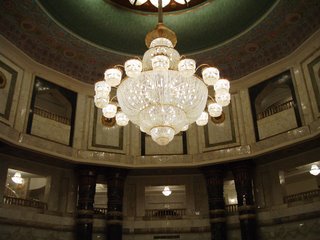Same Subject New Perspectives from Al Faw
I'm going for a different twist on this posting this time. I managed to get some new photos, and used a tripod to get some of them. I am adding a little history along with this post to.
Faw is one of 8 presidential palaces used for hunting and recreation by Baathist party members and Saddam Hussein and his family. Both sons had matching villas on the artificial lake. There were houseboats to move them around, often they would cruise the lake and take tea at one of the artificial islands.
Below a different view of the rotunda. Notice you see eight of the sixteen columns in this view.
New view of the ceiling details.

Visitors walking into the palace are greeted with the words “Peace be to the fighters of the Faw Peninsula.”
The palace is surrounded by a lake and villa complex. The lakes are filled with fish and carp. The rumors that the lake contained bodies of victims of Hussein have not been proven – nor has the lake been drained to find out. The large “Saddam Bass” are a specially bred fish with diamond scales and a green color. (See my below article on the fauna).
This is a closer view of the top of the chandelier.

The bottom of the chandelier,

The building and construction of AL Faw complex was started in 1989 and completed just prior to Desert Storm. It was declared off limits to UN Arms inspectors in 1998 – one of the events which brought Iraq under intense scrutiny
by the US.
Excerpts from a history on Al Faw author unknown. Possibly U.S. Army Historian.
1 comment:
Appreciate being able to read the history behind this opulant palace. Amazing pics!
Post a Comment